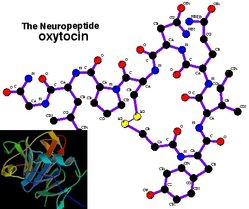Christensen FC, Tehranifar M, Gonzalez JL, Qualls CR, Rappaport VJ, Rayburn WF. Randomized trial of concurrent oxytocin with a sustained release dinoprostone vaginal insert for labor induction at term. Am J Obstet Gynecol 2002; 186:61-5.
* BACKGROUND Simultaneous use of oxytocin and prostaglandin E2 preparations may offer a more efficient approach to labor induction by shortening the induction to delivery time. However, the manufacturer of sustained-release dinoprostone inserts warns against concurrent use with oxyytocin since the risks of uterine hyperactivity and complications are unknown. This study compared the use of oxytocin immediately after placement of a sustained-release dinoprostone insert with delayed use of oxytocin after removal of dinoprostone.
* POPULATION STUDIED The study included 71 women who presented to the University of New Mexico Health Sciences Center with indications for labor induction, singleton gestations with cephalic presentation, intact membranes, reactive nonstress tests, no previous uterine surgery, and unfavorable cervices (Bishop score [greater than or equal to] 6). These patients are similar to those encountered in a primary care setting. Women with vaginal bleeding, more than 2 contractions in 10 minutes, asthma, known hypersensitivity to prostaglandins, or conditions that would contraindicate the induction of labor were excluded.
* STUDY DESIGN AND VALIDITY Women were randomly assigned (concealed allocation assignment) to either low-dose oxytocin infusion (2 mU/min with 2-mU/min increases every 20 minutes, up to a maximum dose of 36 mU/min) started either 10 minutes after placement of a 10-mg sustained-release dinoprostone insert (immediate group) or 30 minutes after the removal of the insert (delayed group). Inserts were left in place for 12 hours if possible. The exact time of dioprostone insert placement into the posterior fornix was recorded. Evaluation of the cervix and Bishop scoring were performed prior to placement and immediately following removal of the insert. Two investigators blinded to group assignment monitored tracings of contractions.
The study included patients who in clinical practice are candidates for induction therapy, and was powered to detect a 6-hour difference in induction to delivery times. However, the sample size was too small to detect differences in morbidities such as difference in cesarean delivery and uterine hyperstimulation. Analysis by intention to treat was not performed. Three women were excluded from the final statistical analysis for protocol violation, no delivery data, and withdrawal of consent.
* OUTCOMES MEASURED The primary outcome measured was the time from induction to delivery. Secondary outcomes included changes in cervical score at 12 hours, frequency of deliveries within 24 hours, incidence of uterine hyperstimulation, rate of cesarean deliveries, and maternal and neonatal complications.
* RESULTS The mean induction to delivery time was 972 minutes in the immediate group versus 1516 minutes in the delayed group (P = .001). The change in Bishop score at the time of the insert removal was significantly greater in the immediate oxytocin group as compared with the delayed oxytocin group (P = .01). Immediate versus delayed administration of oxytocin increased the likelihood of delivery within 24 hours of induction (90% vs 53%, respectively; P = .002). No cases of hyperstimulation syndrome occurred with the immediate group versus 3 cases in the delayed group (P = .24). Cesarean delivery rates were similar (16% vs 13% for the immediate and delayed groups, respectively; P = .73), and cesarean deliveries were needed only in nulliparous women. No women developed intrapartum chorioamnionitis, and 1 woman in each group developed postpartum endometritis. Neonatal Apgar scores measuring less than 7 at 5 minutes were similar between groups (0% vs 6% for the immediate and delayed groups, respectively; P = .49).
RECOMMENDATIONS FOR CLINICAL PRACTICE
Concurrent administration of oxytocin and sustained-release dinoprostone (prostaglandin) reduced the time from induction, to delivery compared to oxytocin after removal of dinoprostone. This study found no increased risk of adverse events with concurrent administration. However, caution should be applied when using this concurrent therapy regimen until maternal and neonatal safety has been properly evaluated with larger studies.
COPYRIGHT 2002 Appleton & Lange
COPYRIGHT 2002 Gale Group



